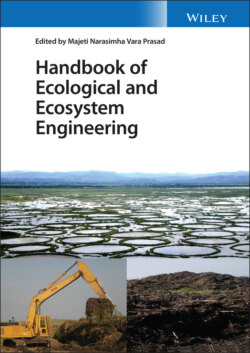Читать книгу Handbook of Ecological and Ecosystem Engineering - Группа авторов - Страница 39
3.4 Priority Areas for Ecological Engineering
ОглавлениеThe world population is growing rapidly and is expected to reach 10 billion by 2050 [5, 25]. With this accelerated population growth, exploitation of natural resources, fragmentation of land and water bodies, and extensive damage to ecosystems are inevitable consequences of urbanization and infrastructure development as a part of modern civilization. The prevailing processes of using non‐renewable natural resources and allochthonous energy inputs for long periods of time impose a future threat to the environment as a consequence of the exhaustion of these resources. Such resources are considered successful providers of energy and services due to their high calorific value.4 Urbanization, on the other hand, is linked to artificial floods, drying up of water bodies, soil erosion, and pollution of all strata of the ecosystem; it ultimately leads to imbalances in the ecosystem, agricultural outputs, and ability to maintain the biodiversity of the planet. A balance between the natural ecosystem and ecosystem engineering services must be retained for the vitality of mankind. It is vital to identify key areas of conservation priorities and meticulously design ecological engineering services with ecological principles and rules to develop and manage structures that effectively enhance industrialization with a reduced impact on the environment.
Xiao and Xiao [63] mathematically identified potential areas and hotspots/coldspots based on the amount of change in ecosystem services (i.e. provisioning, regulating, cultural and supporting services to human obtained from aquatic ecosystems, forest ecosystems, grassland ecosystems and agro ecosystems), assuming 100% conversion of all non‐forest land into forest. The ecological engineers, planners, and managers establish a monitoring program that objectifies decisions, ensures target fulfillment, and addresses social needs. For any restoration project to be successful, there are three primary stages of an effective adaptive management plan: (i) a clear vision and goal statement, (ii) a conceptualized design or model, and (iii) a definite framework [55]. The target or goal statement is a means to evaluate the system's practical applicability that can be assessed with the project's performance criteria. A properly designed model helps in devising a target‐oriented project based on ecological science. A project framework is based on a system‐development matrix by incorporating the knowledge gained through the previous two ingredients required for a project. During the process of implementing ecological engineering models and then developing and restoring a particular region, plausible outcomes must be foreseen and required measures undertaken to correct problems.
The term restoration is defined as any process that focuses on returning a system to its original, pre‐existing situation. The Society for Ecological Restoration has defined ecological restoration as “the process of assisting the recovery of an ecosystem that has been degraded, damaged, or destroyed” [48]. The aim of ecological restoration is to replicate structures with reference to natural ecosystems as a basic model, maintaining biodiversity, functionality, and other parameters. Ecological engineering involves creating and then restoring sustainable ecosystems, thus benefiting both humans and Nature. Some of the major areas that require the attention of ecological engineering projects for development and restoration are discussed next.
